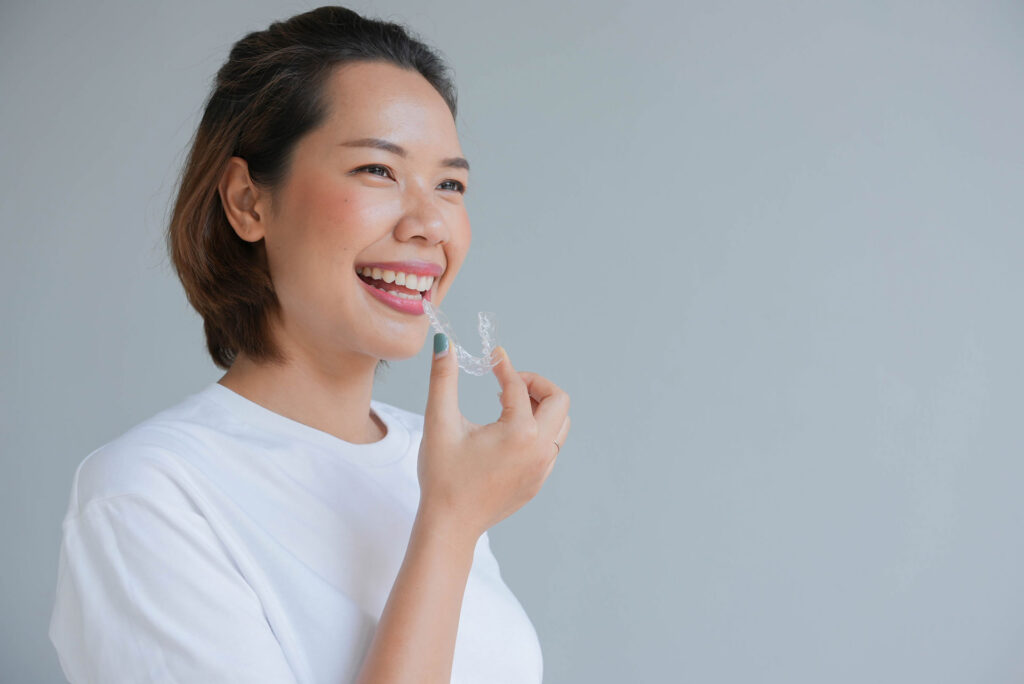
Deciding to straighten your teeth is a significant step towards improving your oral health and smile. With progress in dental technology, there are now more options than ever.
Two popular methods for teeth straightening are Invisalign and traditional braces. This article will explore both options, their benefits, and how they compare to help you make an informed decision.
Invisalign vs Braces
Several factors come into play when considering Invisalign and braces. Here’s a closer look at how they compare regarding appearance, procedure duration, cost, suitability, possible complications, and lifestyle impact.
Appearance
Invisalign: One of the most attractive aspects of Invisalign is its appearance. Invisalign aligners are clear and almost invisible, making them popular among adults and teenagers who want to straighten their teeth discreetly. Since they are custom-made to fit perfectly over your teeth, they are hardly noticeable when you smile or talk.
Braces: Traditional braces are more noticeable. They are made of metal brackets and wires that are affixed to the teeth. While modern braces are smaller and less obtrusive than they used to be, they are still quite visible. For those who are self-conscious about their appearance, this can be a significant drawback.
Duration of the procedure
Invisalign: The length of treatment with Invisalign varies depending on the case’s complexity but typically ranges from 6 to 18 months. Patients receive a series of aligners, each worn for about two weeks before progressing to the next set. Regular check-ups every 6-8 weeks ensure the treatment is on track.
Braces: Traditional braces usually require a longer treatment period, often between 18 months to 3 years. The exact duration depends on the patient’s dental needs. Adjustments are needed every 4-6 weeks to tighten the braces and guide the teeth into their new positions.
Cost
Invisalign: The cost of Invisalign usually starts at $4,000 in Singapore. The price reflects the level of technology and customisation involved in creating the aligners.
Braces: The price of traditional braces can be slightly lower, starting at $3,500. The final cost will depend on the type of braces used (metal, ceramic, lingual) and the length of the treatment.
Suitability
Invisalign: Invisalign is suitable for treating various dental issues, including overcrowding, gaps, and minor bite issues. However, it may not be the best option for severe or complex orthodontic problems. Patients are required to wear the aligners for 20-22 hours a day for optimal results, which requires high compliance.
Braces: Traditional braces are versatile and can handle a wide range of orthodontic conditions, from minor to severe. They are often recommended for complex cases involving significant misalignment or bite problems. Since they are fixed in place, they are effective for patients struggling with compliance.
Possible Complications
Invisalign: Invisalign generally has fewer complications compared to braces. However, some patients may feel sore or uncomfortable when starting a new set of aligners. There is also the risk of losing or damaging the aligners, which can delay treatment.
Braces: Braces can cause discomfort, especially after adjustments. They can also lead to issues such as mouth sores, plaque buildup, and difficulty cleaning the teeth thoroughly. In some cases, the brackets or wires may break, requiring emergency dental visits.
Lifestyle impact
Invisalign: Invisalign aligners are removable, allowing for greater flexibility in eating and drinking. Patients can eat their favourite foods without worrying about damaging the aligners. Oral hygiene is also easier to maintain since the aligners are removable and can be taken out for brushing and flossing. However, the patient is responsible for wearing the aligners as directed.
Braces: Braces are fixed appliances, which means certain foods (like sticky or hard foods) should be avoided to prevent damage. Keeping oral hygiene in check can be more challenging due to the brackets and wires. However, since they are always in place, they work continuously without relying on patient compliance.
Which teeth straightening treatment should you choose?
Choosing between Invisalign and braces depends on the severity of your dental issues, budget, lifestyle preferences, and how discreet you want your treatment to be.
Invisalign is excellent for those who want a nearly undetectable solution with minimal lifestyle disruption, particularly for mild to moderate orthodontic issues. However, if you have a complex case or require significant repositioning of your teeth, traditional braces might be more effective.
You should consult a dentist to evaluate your needs and determine the most suitable teeth straightening option. A consultation would give you a clearer picture of what to expect from each method and help you make a decision that aligns with your goals and circumstances.
Invisalign and Braces in Singapore
Invisalign offers several advantages over traditional braces, including greater aesthetic appeal and minimal lifestyle disruption. However, not everyone is a suitable candidate for Invisalign. Traditional braces may be the more practical option for more severe dental conditions, providing the necessary strength and precision to correct complex orthodontic issues.
At Orchard Scotts Dental, we are committed to helping you determine the best treatment for your needs, ensuring you achieve a healthy, beautiful smile. Contact us today to schedule a consultation.


